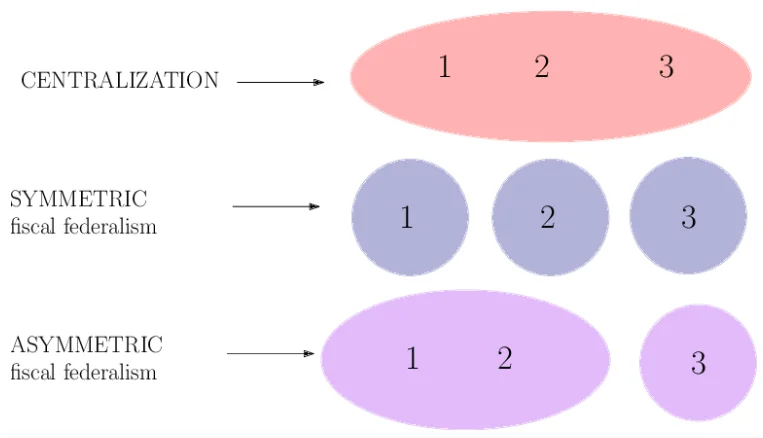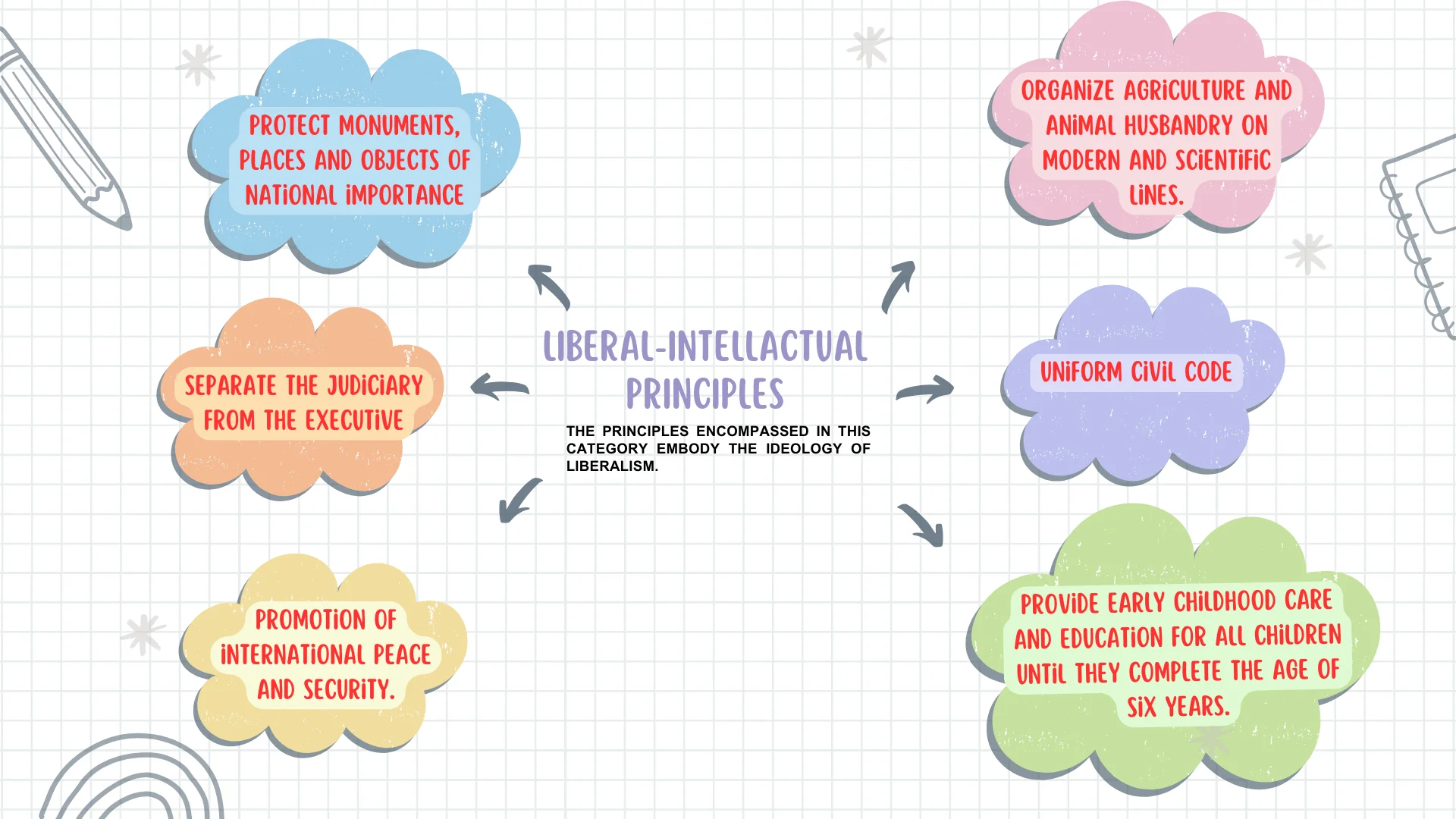Asymmetric federalism is a system of government in which different States or regions have different powers or authorities. This means that not all States or regions are equal in terms of their autonomy or decision-making power. Asymmetric federalism is often used to accommodate the diverse needs and interests of different regions or groups within a country.
Asymmetric Federalism in India
Bargaining, Arrangements, and Stability
Federalism and Bargaining
- Riker’s Theory: Federalism results from rational bargaining among constituents for political or economic gains.
- Political Bargain: Constituents trade political autonomy for security from external threats.
- Economic Bargain: Facilitates a common market and optimal public service provision through economies of scale and catering to diverse preferences.
- Preservation of Identity: Constituents seek to preserve valued identity and special status, motivated by economic, political, cultural, or religious reasons.

Enroll now for UPSC Online Course
Sources of Asymmetry
- Bargaining Strength: Differences in bargaining strength among units lead to asymmetry.
- General Applicability: Issues affecting the majority may lead to greater decentralization and autonomy.
- Specific Applicability: Issues relevant to specific units with strong bargaining power result in asymmetric arrangements.
Types of Asymmetric Arrangements
- De Jure Asymmetry: Enshrined in the constitution or established by tradition.
- De Facto Asymmetry: Observed in the practical working of the federation.
- Evolving Arrangements: May change as units assimilate into the federation or for holding the federation together.
Impact on Federation Stability
- Positive Aspects: Transparent, de facto asymmetry can contribute to nation-building.
- Negative Aspects: Short-term political expediency or administrative discretion can degrade intergovernmental institutions and cause instability.
Discrimination in Centralized Federations
- Central Government’s Role: Has considerable scope for discrimination among units.
- Weak Central Government: Regional parties can wield significant control over a coalition government at the center, leading to potential discrimination.
Significance of Asymmetric Federalism
A distinguishing feature of India’s federal system is its inherent asymmetry. The Indian Constitution establishes a tiered federal structure, clearly delineating the subjects over which each tier of government exercises authority. This asymmetric approach is essential for India’s governance due to several factors:
- Embracing Diversity: India’s rich tapestry of cultures, languages, and religions necessitates a flexible federal system that can accommodate regional and cultural variations.
- Asymmetric federalism provides the framework to address these diverse needs effectively.
- Integration and Accommodation: Asymmetric federalism fosters a system that allows for self-governance within the broader framework of shared rule, adhering to the principle of weighted and differentiated equality.
- This approach ensures that all regions and groups have a voice and a stake in the governance process.
- Protecting Minority Groups:
- By granting greater autonomy and power to regions with concentrated minority populations, asymmetric federalism helps safeguard the interests and rights of these marginalised groups.
- Addressing State-Specific Concerns: Empowering States with greater decision-making authority allows them to tailor solutions to their unique challenges and priorities.
- This decentralised approach ensures that State-specific issues receive the attention and resources they deserve.
- Strengthening Federalism: Asymmetric federalism promotes a balanced distribution of power between the Central and State governments.
- This decentralisation of decision-making strengthens the overall federal structure and enhances the effectiveness of governance.
Asymmetric Features of Indian Federalism
Constitutional Provisions
- Vertical Asymmetry: The Indian Constitution grants the Central government more power than the States.
- For instance, the Central government can unilaterally alter State names and boundaries (Article 3) and impose a national emergency (Article 352).
- Horizontal Asymmetry: States have unequal representation in the Rajya Sabha (upper house of Parliament), with Uttar Pradesh having 31 seats while Arunachal Pradesh has only 1.
- Additionally, Part VIII of the Constitution outlines special provisions for Union Territories, which are Centrally administered regions.
Fiscal Asymmetry
- Finance Commission:
- The Finance Commission determines the share of States in Central taxes. For the 2021-26 period, States are to receive 41% of Central taxes.
- Devolution among States:
- The distribution of funds among States considers factors like income disparity, demographic performance, and forest cover.
- Grants:
- The Central government provides grants to States for various purposes, such as revenue deficits and specific sectors.
Central Sector and Centrally Sponsored Schemes
- Central Sector Schemes: Funded entirely by the central government, with states acting only as implementing agencies.
- Entirely funded by the central government.
- Centrally Sponsored Schemes (CSS): Closed-ended, specific-purpose transfer programs intended to influence state priorities in areas deemed important by the central government.
- Cost is shared between the central and state governments.
- Discretion and Design: These schemes lack constitutional sanctity and are given on a discretionary basis.
- Discretion is involved in the choice of schemes, their design, and implementation.
- New schemes can be introduced to favor particular states or groups of states.
Political Elements in Asymmetric Practices
Initial Political Context
- Indian National Congress Dominance: Initially, the Indian National Congress held power at both central and state levels, reducing scope for centre-state disharmony.
- Single Party Rule: Centralized party structure led to minimal discrimination between states.
Developments Influencing Asymmetry
- Economic Centralization:
-
- Centripetal Bias: Constitution’s strong centralizing tendencies labeled as ‘quasi-federal’.
- Planned Development Strategy: Centralized economic powers and resource allocation.
- Nationalization (1969): Insurance and banks nationalized, increasing central fiscal control.
End of Single Party Rule
- Implications: Strong Prime Minister authority and informal issue resolution through party forums prevented formal intergovernmental systems from developing.
- Shift to Multi Party System: Emergence of regional parties weakened single party dominance.
Emergence of Regional Parties
- Regional Identity: Parties like Dravidian parties in Tamil Nadu, Telugu Desam in Andhra Pradesh, and Biju Janata Dal in Orissa emerged, focusing on regional interests.
- Impact: Shift towards prioritizing regional over national interests.
Coalition Governments at the Centre
- Coalition Dynamics: National parties formed alliances with regional parties to secure power.
- Regional Influence: Regional parties extracted concessions and resources due to their pivotal role in coalitions.
Short-Term Political Horizon
- Electoral Cynicism: Declining trust in politicians and low re-election probabilities (33-38% in recent elections).
- Personal Gains: Representatives prioritize personal gains over electorate welfare.
Resulting Dynamics
- Central Government’s Financial Strength: Remains strong but with reduced power to counter strong state demands.
- Regional Bargaining Power: States with significant parliamentary strength secure higher resources.
- Discretionary Transfers: High proportion of discretionary transfers leads to fiscal asymmetry.

Enroll now for UPSC Online Course
| Must Read | |
| Current Affairs | Editorial Analysis |
| Upsc Notes | Upsc Blogs |
| NCERT Notes | Free Main Answer Writing |
Conclusion
Asymmetric federalism in India supports the integration and accommodation of diverse regional identities and interests.
- By granting different levels of autonomy and addressing specific regional concerns, it strengthens the overall federal structure.
- This system promotes balanced development, protects minority interests, and enhances cooperative governance between the Central and State governments.
Sign up for the PWOnlyIAS Online Course by Physics Wallah and start your journey to IAS success today!
| Related Articles | |
| Preamble Of The Indian Constitution | Federalism |
| National Party: Status, Criteria, and Advantages | Indian National Congress |

 GS Foundation
GS Foundation Optional Course
Optional Course Combo Courses
Combo Courses Degree Program
Degree Program









